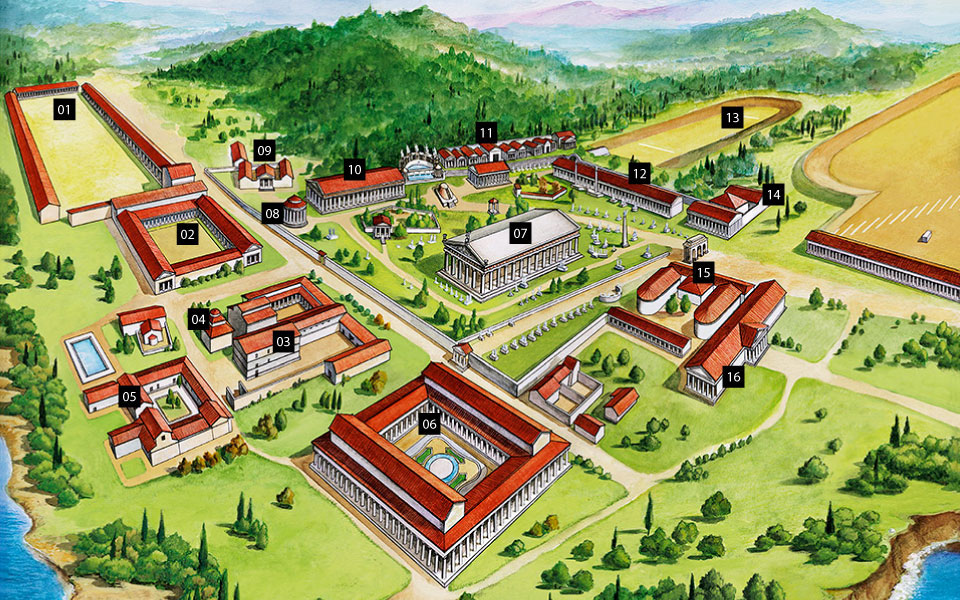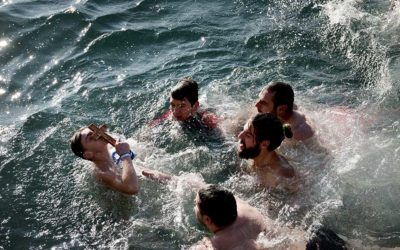The sanctuary of Ancient Olympia and the role it played in the Olympics.
An ancient Greek sanctuary was a sacred space reserved for the worship of a deity by his or her followers. Sometimes a sanctuary was a small place featuring only a simple altar or shrine. Panhellenic sanctuaries, which ultimately drew pilgrims, athletes and other travelers from all over ancient Greece and neighboring regions, were large, highly developed complexes that served many functions and could accommodate their visitors’ diverse needs.
Olympia, as the leading panhellenic sanctuary of the ancient Greek world, represents the most sophisticated, instructive paradigm of such a complex. Around its early altars and shrines grew up a cluster of monumental Archaic and Classical temples or precincts dedicated to Hera, Pelops, Zeus, and Rhea/Cybele (the Metroon), all located within the sanctuary’s sacred central grove, the Altis. Also in the 6th and/or 5th century BC, two administrative buildings were constructed on the Altis’ north and south sides: The Prytaneion, where officials, priests and Elean VIPs met, dined and received victorious athletes and official envoys; and the Bouleuterion, home to Elis’ Olympic Council and the sanctuary’s archives, where judges and athletes took oaths to uphold the rules and a special court examined cases of cheating or unfair competition. An elevated row of treasuries (storehouses for valuable offerings) belonging to different city-states were installed on a terrace northeast of the Altis.
Simple facilities for athletic competitions appeared during the Geometric era (9th, 8th century BC) as part of the sanctuary’s core infrastructure. The earliest stadium stood just beside the Great Altar of Zeus. As the Olympic Games increased in importance, and more and more athletes and spectators arrived, the stadium’s location gradually shifted eastward to its present, more spacious position. Additionally, a hippodrome was laid out nearby for equestrian races. A palaestra and gymnasium provided practice spaces for boxing, wrestling, jumping, running and the throwing of the javelin and discus. The palaestra was also used for instruction, recreation and the oiling and sanding of athletes’ bodies.
To protect visitors from sun and rain, roofed, colonnaded shelters (South Stoa, Echo Stoa) were erected. A massive banqueting hall, the Leonidaion, offered 80 couch-lined rooms for ceremonial dining, while, by Roman times, bathing could be enjoyed at a half-dozen different establishments. Nighttime accommodation was found at several hostels, or in makeshift camps surrounding the sanctuary. When not competing, athletes could gather in clubhouses (leschai) such as that preserved at Olympia’s southwestern corner. Visible throughout the sanctuary would have been dedicatory statues and other votives, as well as impressive monuments erected by or for VIPs (Philippeion, Nero’s triumphal arch/entrance). Many of these features were also characteristic of the panhellenic complexes at Delphi, Isthmia and Nemea, as well as Epidaurus and other large sanctuaries. One question remains: was there no theater or odeon at Olympia, for dramatic or musical performances? The earth still holds its secrets.
VENUES
1. Gymnasium
2. Palaestra
3. Pheidias’ workshop
4. Heroon
5. Greek and Roman baths
6. Leonidaion
7. Temple of Zeus
8. Philippeion
9. Prytaneion
10. Temple of Hera
11. Treasuries
12. Echo Stoa
13. Stadium
14. Nero’s Villa
15. Bouleuterion
16. South Stoa
PANEHELLENIC GAMES BEYOND OLYMPIA
Just as the modern Olympics represent a flagship event in sports but not the only athletic show in town, so in ancient Greece the widely popular Games held every four years at Olympia were not the only known athletic competition. Nowadays, athletes prepare for the Olympics by participating in regional qualifying events. In antiquity, they could ready themselves for Olympia by first attending three other major panhellenic events – at Delphi, Isthmia and Nemea.
Athletes had numerous opportunities, in fact, to demonstrate their physical prowess, since athletic contests, large and small, were a ubiquitous feature of life in post-8th century BC Greece, much as they are today for sports fans. Nevertheless, the Games at Olympia were special; the culmination of a four-year, four-sanctuary sporting circuit that drew the best competitors.
The four venues for the panhellenic games, located within a central geographical zone stretching across mainland Greece, allowed convenient access to visitors coming from all corners of the Greek world. Athletics and religion intermingled from earliest times and sanctuaries served as traditional public gathering spots, especially during religious festivals. Pilgrims and athletes celebrated top gods in diverse settings: Apollo at Delphi, among mountains and forests; Poseidon at Isthmia, beside the sea; and Zeus at Nemea and Olympia, amid rich inland agricultural districts.









